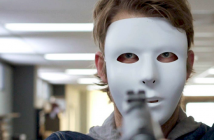
Editor’s Notes: The following review is part of our coverage for the Los Angeles Film Festival. For more information on the festival visit http://www.lafilmfest.com/ and follow the Los Angeles Film Festival Festival on Twitter at @LAFilmFest.
The Vanished Elephant begins with crime novelist Edo Celeste (Salvador del Solar) concluding the serial tales of his detective character Felipe Aranda. Yet as he wraps up the fictional world that he has constructed, irony of ironies, he finds before long that the mystery has only begun in the real world when a series of events ties him back to the unsolved disappearance of his fiancee seven years ago. Celeste, whose instincts have been shaped as a writer and former detective, embarks on an inward spiral of a journey that takes him from the urban spaces of Lima to the desert peninsula of Paracas, from the pages of his crime fiction to the memories of his love. Barring the last half hour or so, for his second feature Javier Fuentes-León crafts a genuinely compelling journey with Celeste. The twists and turns are unexpected and clever while the story’s underlying core of the fallacy of perception and, to a lesser extent, trauma (personal and collective) give substance to the journey.
Barring the last half hour or so, for his second feature Javier Fuentes-León crafts a genuinely compelling journey with Celeste.
From the outset, the film establishes its play with the boundaries between the real and the fictional, the past and the present. The opening sequence starts with a man who arrives at a house. It is nighttime. His gun in hand, he proceeds to inspect each corner of the rooms; with each flick of the shoulder and turn of the head, the tension builds until he finds something crawling on a bed and discovers a corpse on top of a wardrobe cabinet. And then the scene stops, since Celeste is hard-pressed as to what to write next for his alter-ego detective Aranda, on his laptop. As Celeste leans back on his chair trying to figure out what to do with Aranda, the camera focuses on photos of a woman on the laptop while Celeste takes his cell phone and listens to a message from, presumably, the same woman. This woman turns out to be Celia (Vanessa Saba), Celeste’s fiancee who disappeared in 2007.
 The film’s mystery begins, or unravels, soon after at Celeste’s front door. Literally. The doorbell rings and two men take him to an out-of-the-way place to meet with an unknown woman named Mara (Angie Cepeda), and his reality is never the same. Or rather, he begins to mistrust his reality. This first encounter with Mara puts Celeste on a scavenger hunt that provokes more encounters: with a photographer who stages an exhibition of scenes gleaned from Celeste’s novels; a district attorney who has also experienced the disappearance of a loved one; and a man who seems to be the doppelganger of his fictional detective. Which is real and which is imagined becomes increasingly difficult to distinguish for Celeste, and thus the spectator.
The film’s mystery begins, or unravels, soon after at Celeste’s front door. Literally. The doorbell rings and two men take him to an out-of-the-way place to meet with an unknown woman named Mara (Angie Cepeda), and his reality is never the same. Or rather, he begins to mistrust his reality. This first encounter with Mara puts Celeste on a scavenger hunt that provokes more encounters: with a photographer who stages an exhibition of scenes gleaned from Celeste’s novels; a district attorney who has also experienced the disappearance of a loved one; and a man who seems to be the doppelganger of his fictional detective. Which is real and which is imagined becomes increasingly difficult to distinguish for Celeste, and thus the spectator.
The film presents this blurring of the real and the fictional in a smart, suspenseful, even self-referential way, using elements that are known for their ambivalence in source and/or meaning even as they are grounded in reality, namely, sound and photography.
The film presents this blurring of the real and the fictional in a smart, suspenseful, even self-referential way, using elements that are known for their ambivalence in source and/or meaning even as they are grounded in reality, namely, sound and photography. When Celeste enters a place, sometimes sounds of the radio or television waft through the air, producing an eerie sense of presence-absence and suspense. The first time we hear Celia’s message on Celeste’s voicemail, we think it is from the present. It is actually the last time he heard from her before her disappearance. But he listens to it almost on a daily basis, to remind himself of her voice but also inadvertently of her absence. That she disappeared on the day that an actual 8.0 magnitude earthquake hit Peru further blurs the lines between the real and the fictional, pushing the film into the reality of the spectator. (In fact, the film’s title refers to the earthquake, in a sense, which is alluded to in the film.)
Throughout his journey, Celeste also accumulates jigsaw puzzle photographs that he pieces together on his wall at home, which slightly recalls Michelangelo Antonioni’s Blow-Up (1966). The reference is not accidental: both films have as an inspiration a short story by Argentine writer Julio Cortázar. How Celeste pieces together the photographs to create a whole is also related to a short story within the film (whose author strangely refers back to Celeste’s journey). Then there is the photography exhibit, made of scenes from Celeste’s own crime stories, which in turn recall the covers of American pulp fiction novels. While the film itself is sober and serious in tone, these layers of circularity betray a playfulness at the level of form and structure, which makes it even more intriguing.
The film also plays with film noir tropes, at times using them to make the spectator think one way about a character or situation but not following through with it. One of these tropes is the femme fatale, which could have been easily represented by Mara: mysterious and aloof, she even wears a trench coat for one sequence when she accompanies Celeste on an outing. Another of these tropes is the anti-hero detective embodied by ex-detective Celeste, who takes it upon himself to pursue his pseudo-investigation of things; but the more he doggedly pursues clues, the less he actually knows about the case and himself.
Still another trope is the unconventional, convoluted narrative structure, which leads to the film’s only drawback. As the temporal and psychological twists and turns pile up, building an ever more intricate stairway, the last twenty-thirty minutes feel spent and leave the story more ill-defined than in the beginning. But perhaps it is intentional, thus mirroring the film’s illusory commencement of ending a story when it is, in fact, only beginning?
As the temporal and psychological twists and turns pile up, building an ever more intricate stairway, the last twenty-thirty minutes feel spent and leave the story more ill-defined than in the beginning. But perhaps it is intentional, thus mirroring the film’s illusory commencement of ending a story when it is, in fact, only beginning?



